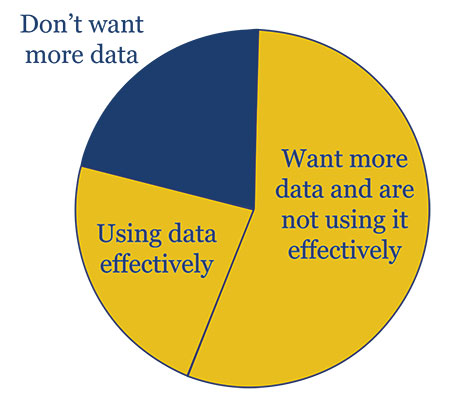Unlocking Marketing Data Analytics

If content is king, then data is the ace in your pocket.
And it's no wonder: As more marketing efforts continue to live in the digital sphere, savvy marketers need to identify their key performance indicators (KPIs) and synthesize the resulting data to see if their efforts were a big-win or crash-and-burn.

Strategic marketer Stephan Sorger–an honored instructor for the past 13 years–is on the bleeding-edge of marketing analytics. Nearly 10 years ago, Sorger developed the first marketing analytics course on the West Coast at UC Berkeley Extension. He continues to adapt his courses to reflect new requirements in the workplace so that his students are best-prepared to succeed. "We teach the technologies that companies are looking for—R, Tableau and SQL," Sorger says. "One of the growing trends is toward open-source software, so we really emphasize that. Companies are looking for the next level of analytics, such as market sizing–whether the market is growing or shrinking."
Sorger sat down with us to discuss where this dynamic field is headed.
Marketing and Data Science Will Be the New Dynamic Duo
The next frontier for marketing teams is finding cohesive alignment with their data science counterparts... with predictive analytics driving targeted communication with consumers. Data is the rocket fuel for marketing's future.
—Kevin Brown, SVP and Head of Marketing at Credibly, a Fintech lending platform that provides access to capital for U.S.-based SMBs, Courtesy Forbes.com
On the Top Four Trends:
1:
If you look at location-based social media such as Foursquare, five years ago everyone was checking in and wanted to be mayor of the local café. I can't remember the last time I checked in anywhere and neither do my students. That's a shrinking market; in fact, Foursquare has pivoted a bit, adopting its new tagline "Foursquare is your ultimate city guide, in your pocket." At the same time, many data scientists are seeking to gain insight from social media, especially in hot areas such as sentiment analysis, target group discovery and social media strategy ROI. Those fields offer ripe opportunities for budding marketing analysts.
2:
Market segmentation determining which segment we should target. For example, Foursquare's looking at how to target different people, or keeping the people that they already have while introducing new services that are relevant to them. Today's market requires a sensitivity to different market segments. In the past we treated everyone equally, but I think those days are over. We need to start looking at the differences among people. In my courses, we study different data analysis methods, such as Ward's Method and K-Means to identify differences in the way people behave and leverage those differences to form distinct market segments. Often, the different market segments hold different values for similar products and services, and we can increase profitability knowing that information. For example, UPS will ship the exact same package from the exact same source address to the exact same destination address for eight different prices–anywhere from less than $10 for UPS Ground to more than $150 for next-day air morning. Different groups select different services, depending on their desires. The alternative would be to price all UPS services at $30 a package, which would alienate segments who seek value and leave money on the table for segments who seek convenience.
3:
Competition. What are our competitors doing and should we be worried about it? One company to watch right now is Facebook. Their stock is up because they're basically gobbling up everyone else's lunch. They figured out how to buy the competitors. That gives marketing analysts two basic choices: position themselves to be acquired or decide to stay private and be in it for the long haul. For example, Facebook founder Mark Zuckerberg rejected a $10 million offer for his company back in 2004. That's a lot of money for a 20-year-old to turn down.
4:
Metrics. What metrics and what kind of numbers should we be tracking? As I'm designing the development of my organization, I'm trying to figure out which way I want to grow. One big question is: What is important to the organization? Knowing what we need to track is key and goes way beyond web analytics. A lot of people use the wrong data and don't clean the data before they use it. And they make faulty assertions based on the data by measuring the wrong things–things with a lot of bias in them–so they make faulty assumptions based on faulty data. The key to avoid this mistake is to understand the situation at hand. That's why we spend so much time in my classes covering the meaning behind the data. For example, one of our case studies dealt with real-estate forecasting in the tiny area of Burlingame, California. One of my students estimated the average value at more than $3.4 billion. Granted, San Francisco Bay Area real estate is expensive, but it has not made it into the billions yet. This person clearly did not understand the meaning behind the data.

Of the 74% of enterprise architects that would like more data, only 29% of them feel like they make good use of it.
Courtesy Marketing Profs
On Predictive Analytics:
According to Forbes, we have created more data in the past two years than in the entire history of the human race. By 2020, we will be collecting 1.7 megabytes of new information every second from every individual on the planet. The big question is, "How do we glean insight from all this data in a meaningful way?" Businesses are leveraging the data through predictive hypothesis testing to assess the potential impact of their marketing programs before launching them–not just to save money, but also to increase effectiveness.
On Working With the C-Suite to Drive Revenue:
Companies have been collecting terabytes upon terabytes of data. A great analytics platform is where the CEO works with data analysts and marketing analysts to figure out what to measure, and then looks at how they can make changes to that day after day. We will ask the CEO or other visionary, "What vision do you see for the company?" I would constantly get together with the CEO and the CFO to find out what metrics are important to the business, and then I'd look at what levers I could pull to realize those metrics.
We'll keep that answer in mind as we analyze the data, as well as the principal takeaways I have in the context of the CEO's vision for that company. The big issue is how to translate a vision into something we can measure. For example, Jeff Bezos, the CEO at Amazon.com, goes beyond the traditional metrics of customer count, revenue and growth to look at longer-term issues, such as customer service and alternative distribution mechanisms. He laid out his long-term vision for the company way back in 1997, when he wrote a letter to amazon.com shareholders. Someone like Bezos would require a very different approach to measuring success than someone with a very short-term focus, such as Hewlett-Packard.
Executives are looking to Big Data to provide the Big Answers they need to win in today's competitive markets. And data scientists can deliver. But they often present data using language that does not resonate at the strategic level that C-Suite leaders need. That is why professionals need the type of learning framework we offer that merges Science with Strategy, and Formulas with Finance.
On Data Informing Customer Value:
Where customers are right now is number one. Number two is where they're going to be over their lifetime, and that's something companies like Amazon and Netflix deal with quite a bit. People realize that they just don't want one sale, they want multiple sales. Amazon does that with its Prime membership: They realized that the customer is truly an asset over the long term. Companies like Netflix offer original programming to keep people on board over time.
On Employment Opportunities:
I certainly see a trend in the marketplace of companies wanting to have more data science and analytics skills, not just for analytics positions but also for all positions within marketing and business. I think companies will be looking for that more and more as time goes on, so if you haven't picked up some of the basics yet, it's definitely time to do so.
One of the things that UC Berkeley Extension provides is the structured approach to learning. We've taken our best course offerings and packaged them into sequences and certificates that allow you to quickly get up to speed so you don't have to figure out which classes work together. We've taken the time to develop a sequence that will give you the background necessary for analytics. You really want to learn from the best, and Extension screens its instructors for people who are skilled academically and professionally. They've worked in this field a long time, are effective teachers and are very passionate about their subject.
Learn more about the Certificate Program in Marketing.
Stephan Sorger, M.B.A., M.S., PE, is the vice president of strategic marketing at the consulting firm On Demand Advisors, has held leadership roles in marketing and product development at companies such as Oracle, 3Com and NASA, and has also developed multiple textbooks, including "Marketing Analytics: Strategic Models and Metrics."
